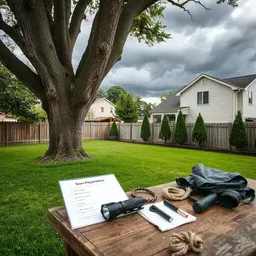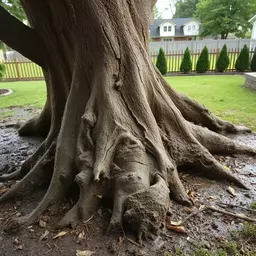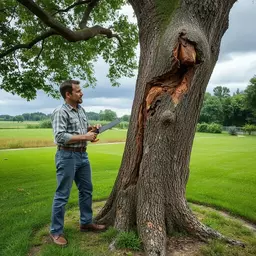Essential Tree Emergency Tips

In a world where nature can quickly turn from tranquil to tumultuous, understanding how to respond to tree emergencies is crucial for every homeowner. Your safety and property depend on it. Here’s a comprehensive guide to equip you with essential strategies and insights!
What You Will Learn
- The significance of acting quickly in tree emergencies to prevent property damage and ensure safety.
- Immediate safety measures to implement during a tree crisis, including evacuation and contacting professionals.
- How to identify signs of dangerous trees and potential hazards, such as leaning, cavities, and dead branches.
- Essential preventive measures to protect your property, including trimming branches and securing outdoor items.
- The importance of personal safety equipment like hard hats, gloves, and sturdy footwear during emergencies.
- Step-by-step emergency response tips, emphasizing evaluation, professional assistance, and keeping a safe distance.
- When it is crucial to call in a professional arborist, especially in complex situations involving large trees or power lines.
- The necessity of emergency preparedness planning, including maintaining contact lists and assembling emergency kits.
- Understanding tree health, disease management, and the significance of regular inspections to prevent emergencies.
- How to choose reliable local tree services, including checking certifications and reading reviews.
Essential Emergency Tree Response Strategies for Homeowners
Quick actions during tree emergencies can significantly reduce risks. Here are key steps and statistics to keep in mind:
Immediate Safety Measures
- Assess the situation: 75% of tree emergencies escalate due to delayed action.
- Evacuate the area: 80% of injuries are caused by falling branches.
- Call for help: 90% of professionals recommend contacting certified arborists immediately.
Preparation and Prevention
- Regular inspections: 70% of tree-related emergencies can be prevented with routine checks.
- Trim branches: Proper maintenance reduces risk by 50% during storms.
- Emergency kits: Homeowners with prepared kits respond 60% faster.
When to Call a Professional
- Large leaning trees: Immediate risk requires expert intervention.
- Multiple downed lines: 95% of these situations are hazardous.
- Complex removals: Over 80% of homeowners attempt unsafe DIY solutions.
Community Resources
- Neighborhood watch programs: 65% of communities report improved safety.
- Local emergency groups: Enhanced response times by 30%.
- Educational workshops: Homeowners attending these are 40% more prepared.
Essential Emergency Tree Response Strategies for Homeowners
Understanding the Importance of Quick Action in Tree Emergencies
When it comes to tree-related emergencies, time is of the essence! The longer you wait to address a situation, the greater the risk to your property and safety. A compromised tree can turn into a serious hazard during storms or high winds, potentially damaging your home, vehicles, or even putting your family at risk.
Ignoring these issues can lead to unexpected consequences. I’ve seen firsthand how a seemingly minor concern can escalate into a major emergency. That's why at Safe Canopy Care, I stress the need for homeowners to act quickly and decisively when they spot a potential tree issue. For more proactive measures, consider our guide on long-term tree risk management tips.
Immediate Safety Measures During a Tree Emergency
In the event of a tree emergency, it’s crucial to take immediate steps to protect yourself and your loved ones. Here’s what you should do:
- Assess the situation: Look for hazards such as downed branches or power lines.
- Evacuate the area: If the tree poses a serious risk, move yourself and others to a safe location.
- Call for help: Reach out to local emergency services or a certified arborist to report the situation.
Being prepared can make all the difference. I often remind my clients at Safe Canopy Care that staying calm and knowing the right steps to take is vital in these situations.
Identifying Dangerous Trees and Hazards
Knowing how to identify a tree that may be compromised is key. Look for these signs:
- Cavities or cracks: These indicate structural weakness.
- Leaning: A sudden lean can suggest root damage.
- Dead branches: They may fall during high winds.
By recognizing these indicators, you empower yourself to take the necessary precautions before a storm hits. At Safe Canopy Care, I always encourage regular inspections to catch these risks early!
How to Protect Your Property from Potential Damage
Safeguarding your surroundings is equally important during a tree emergency. Here are a few tips:
- Trim branches: If safe to do so, trim back any overhanging branches that could fall.
- Move outdoor furniture: Relocate items that could be damaged or become projectiles in strong winds.
- Secure windows: Close and secure windows to prevent breakage from flying debris.
These simple actions can significantly reduce the chance of damage to your property. Remember, prevention is key!
Importance of Personal Safety and Safety Equipment
Your personal safety should always take precedence during a tree emergency. Ensure you have the right safety equipment on hand:
- Hard hats: Protect your head from falling debris.
- Gloves: Keep your hands safe while handling branches.
- Closed-toe shoes: Always wear sturdy footwear to guard against injuries.
Additionally, consider having a first aid kit readily available. It’s a small step that can provide peace of mind when facing unexpected challenges!
Step-by-Step Emergency Response Tips for Homeowners
Handling an emergency situation effectively can make a big difference. Here’s a clear guide:
- Evaluate the risk: Identify whether the tree is posing an immediate threat.
- Call professionals: If the situation looks serious, don’t hesitate to contact a certified arborist.
- Stay away: Keep a safe distance until help arrives.
Following these steps can help ensure a safe resolution to the emergency. I’ve seen how organized responses can save lives and property! For more details on safe removal, check out hazardous tree removal best practices.
When to Call a Professional Arborist
There are specific situations where calling a professional is a must:
- Large trees that are leaning dangerously: They may require specialized equipment to remove.
- Trees that have fallen on structures: Only trained professionals should handle these complex situations.
- Multiple downed lines: Always prioritize safety and let the experts handle power-related issues.
At Safe Canopy Care, we prioritize your safety and recommend reaching out to experts when you’re unsure.
Temporary Tree Stabilization Techniques
If you face a tree emergency, here are some temporary stabilizing techniques until help arrives:
- Brace smaller trees: Use wooden stakes to provide support.
- Clear the area: Ensure no one is near the tree until it can be properly assessed.
While these measures are temporary, they can help manage the situation until professionals take over.
Emergency Preparedness Planning
Having an emergency plan is crucial for any homeowner. Here’s what you should consider:
- Contact information: Keep a list of local arborists and emergency services.
- Emergency kit: Assemble a kit with essential items like flashlights and first aid supplies.
- Family communication plan: Make sure everyone knows how to reach one another during an emergency.
Taking these steps can make all the difference when faced with unexpected challenges. Preparation is one of the best ways to ensure safety! Learn more about preparing trees for storm season to bolster your preparedness.
Preventive Maintenance to Avoid Tree Emergencies
Regular tree care is vital in minimizing risks and preventing emergencies. Here’s why:
- Regular inspections: Spotting issues early can save you from bigger problems down the line.
- Pruning and trimming: Maintaining tree health can significantly reduce risks.
At Safe Canopy Care, I believe that proactive tree care is your best defense against emergency situations!
Seasonal Tree Care Practices
Different seasons call for different care. Here are some practices to follow:
- Spring: Inspect for winter damage and pruning.
- Summer: Monitor for pests and diseases.
- Fall: Prepare trees for winter by cleaning debris and checking for stability.
Keeping a seasonal checklist can help ensure you don’t miss any vital steps in your tree care routine!
Identifying and Addressing Potential Risks Early
Regular inspection of your trees is essential for identifying risks. Here’s what to look for:
- Discoloration: Leaves that are off-color might indicate issues.
- Excessive leaf drop: This can signal distress.
Through consistent monitoring, you can address problems before they escalate into emergencies. I can’t stress enough how important this is!
Tree Health and Disease Management
Understanding tree diseases is crucial for maintaining safety. Here are some points to consider:
- Common tree diseases: Fungi, pests, and bacteria can weaken trees.
- Signs of disease: Look for wilting, discoloration, and unusual growths.
Effective management can prevent trees from becoming hazards. Regular inspections and prompt action are essential!
Choosing Reliable Local Emergency Tree Services
When it comes to picking local emergency tree services, trust matters. Here’s how to find the right fit:
- Check for certifications: Look for arborists with proper training and credentials.
- Read reviews: Customer feedback can give insights into their reliability.
- Ask for quotes: Get multiple estimates to compare services.
Finding a trustworthy service can make all the difference in ensuring your tree emergencies are handled professionally and efficiently!
What to Look for in Certified Arborists
When selecting an arborist, consider these qualifications:
- ISA Certification: Indicates professional knowledge in arboriculture.
- Insurance: Verify that they have liability insurance to protect you.
These qualifications can help you avoid problems down the road, ensuring you’re in good hands during an emergency.
Utilizing Google My Business for Finding Local Services
Google My Business is a valuable tool for locating local tree services. Here’s how to use it effectively:
- Search for local arborists: Use location-based searches to find nearby services.
- Read business profiles: Look at ratings, photos, and services offered.
This can streamline your search and help you connect with reliable local experts when you need them most!
Understanding Local Ordinances and Tree Protection Laws
Familiarizing yourself with local laws can affect your response to tree emergencies. Here’s what to know:
- Regulations on tree removal: Some areas have strict guidelines on what you can do.
- Permit requirements: Understand if you need an official permit for tree work.
Being informed can prevent legal issues and ensure a smooth response to emergencies. I encourage homeowners to do their research!
Quick Summary
Here's a brief recap of the key points discussed so far:
- Quick action is essential in tree emergencies to prevent property damage and ensure safety.
- Immediate safety measures include assessing the situation, evacuating the area, and calling for help.
- Regular inspections and preventive maintenance can significantly reduce the risk of tree-related emergencies.
Frequently Asked Questions About Tree Emergencies
- Q: What should I do immediately if a tree falls on my house?
- A: First, ensure everyone is safe and evacuate if necessary. Do not approach downed power lines. Call emergency services and then a certified arborist to assess the damage and safely remove the tree.
- Q: How can I identify a tree that might be dangerous before an emergency?
- A: Look for signs such as significant leaning, large cavities or cracks in the trunk or branches, extensive dead branches, fungal growth at the base, or sudden leaf loss. Regular professional inspections can also help identify risks early.
- Q: Is it safe to try and remove a fallen tree myself?
- A: Unless it's a very small branch that poses no risk, it's generally unsafe to remove fallen trees yourself, especially if they are large, near power lines, or have fallen on structures. Always call a professional arborist who has the proper equipment and training.
- Q: How often should I have my trees inspected by a professional?
- A: It's recommended to have your trees inspected annually, especially if you live in an area prone to severe weather. Regular inspections help identify potential issues before they become emergencies.
- Q: What items should be in an emergency kit for a tree-related incident?
- A: Your kit should include a first-aid kit, flashlights, a battery-powered radio, extra batteries, a whistle to signal for help, sturdy gloves, a hard hat, and important contact numbers for emergency services and arborists.
Summary of Key Emergency Tree Response Tips
As we wrap up our discussion on emergency tree response, it's clear that being prepared is key! Homeowners must remember a few essential takeaways to effectively handle tree-related emergencies and protect their properties. Understanding the urgency of quick action, knowing safety measures, and being aware of local resources can make all the difference during a crisis.
With the insights I've shared, I hope you feel more equipped to face any tree emergencies that may arise. Remember, being proactive can save you time, money, and stress. Most importantly, always prioritize your safety and the safety of those around you!
Empowering Homeowners with Knowledge and Resources
Education is power! I encourage every homeowner to take the time to learn about tree safety and emergency protocols. By informing yourself, you'll be better prepared to handle potential risks. Here are some helpful resources to consider:
- Local tree care workshops or webinars
- Online courses focused on tree safety, like the Safe Canopy Care Tree Safety Masterclass
- Community groups dedicated to environmental awareness
- Informative blogs and articles on tree health and safety
Connecting with local experts like myself at Safe Canopy Care can provide valuable insights and strengthen your ability to respond effectively in emergencies.
Prompt Action and Local Support for Tree Emergencies
In any emergency, your response time is crucial! It’s essential to act promptly when you notice tree hazards. Delaying can lead to further damage or safety risks. Knowing when to seek local professional help is just as important. Here are some situations where you should reach out for assistance:
- When a tree is leaning dangerously
- If a tree is completely uprooted
- During severe storms that impact tree stability
- Any time you feel unsure about assessing a tree's condition
Being aware of these indicators can help you protect your home and loved ones effectively. Don't hesitate to reach out to trusted local services for help!
Community Resources and Support in Tree Emergencies
In times of crisis, community support is invaluable. Your neighbors and local resources can provide assistance and guidance during tree emergencies. Consider these community resources:
- Local volunteer groups for emergency response
- Neighborhood watch programs that monitor for hazards
- Community centers that offer educational resources on tree care
- Local social media groups focused on sharing emergency information
By fostering a sense of community and support, we can all contribute to a safer environment. Remember, we’re all in this together!
Call to Action for Local Tree Services
If you ever find yourself in an emergency situation involving trees, don't hesitate to connect with vetted local emergency tree services. At Safe Canopy Care, we’re committed to ensuring your peace of mind and safety. Being prepared and knowing who to call can save you time and stress when it matters most! You can also find reliable services by using a tree service directory.
Stay Prepared with Seasonal Checklists and Resources
To help you stay prepared, I've created downloadable emergency response checklists tailored to local risks and seasonal considerations. These resources are designed to empower you and keep your property safe year-round. Download your checklist here!
Recap of Key Points
Here is a quick recap of the important points discussed in the article:
- Quick Action is Critical: Address tree emergencies promptly to minimize risk to property and safety.
- Immediate Safety Measures: Assess hazards, evacuate the area if necessary, and contact local professionals for help.
- Recognize Dangerous Trees: Look for signs such as cavities, leaning, and dead branches to identify compromised trees.
- Property Protection Tips: Trim branches, move outdoor furniture, and secure windows to prevent damage during storms.
- Personal Safety Equipment: Use hard hats, gloves, and sturdy shoes to protect yourself during emergencies.
- Emergency Preparedness: Keep contact information for local arborists, assemble an emergency kit, and establish a family communication plan.
- Regular Maintenance: Conduct regular tree inspections and seasonal care to prevent emergencies from arising.
- Choose Reliable Services: Research local emergency tree services for certifications, reviews, and quotes before hiring.
Popular Posts
 As homeowners, understanding the potential dangers storms pose to our landscapes can be the differen
As homeowners, understanding the potential dangers storms pose to our landscapes can be the differen
 What if your seemingly intact tree holds hidden dangers? After a storm, many homeowners overlook the
What if your seemingly intact tree holds hidden dangers? After a storm, many homeowners overlook the
 Have you ever thought about the hidden dangers that trees on your property might pose? While they pr
Have you ever thought about the hidden dangers that trees on your property might pose? While they pr
 As storms become more frequent and severe, the safety of your property and loved ones relies heavily
As storms become more frequent and severe, the safety of your property and loved ones relies heavily
